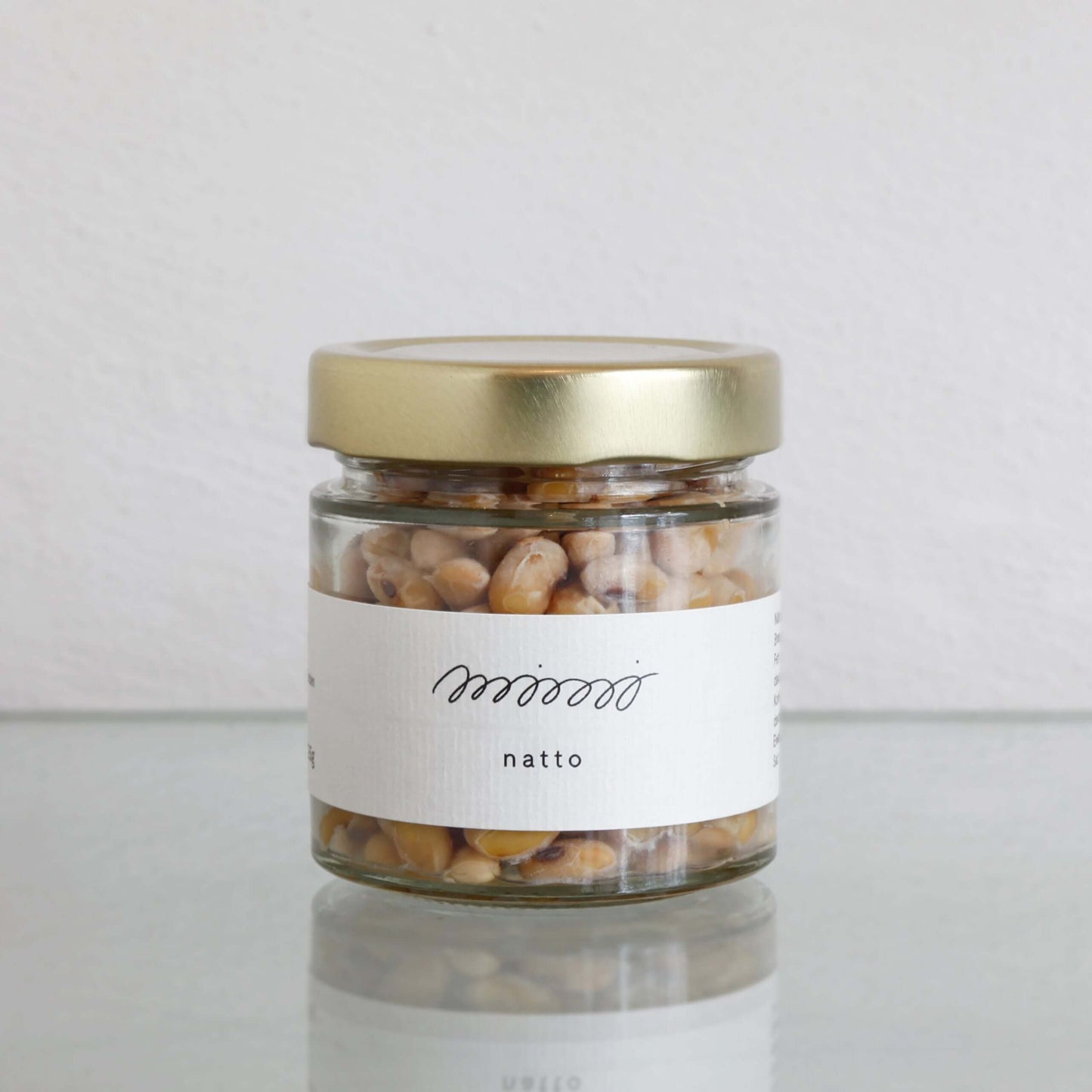natto 125g
natto 125g
- Traditional superfood made from German organic soya beans
- Freshly prepared and available in jars
- Caution: Sticky and intense odour!
Couldn't load pickup availability
Share

Collapsible content
Beschreibung
Our organic natto made from German soya beans is fermented directly in the jar and produced fresh every month.
Natto is a traditional Japanese speciality made from soybeans that are fermented with Bacillus Subtilis. This process creates its very sticky consistency and its unmistakable, mildly cheesy to nutty flavour, which is reminiscent of Camembert. The taste, smell and appearance of the sticky soya beans take some getting used to for many people in Europe, so it is only for connoisseurs or those who like to experiment!
However, natto is also considered a superfood with many health-promoting properties. Our natto - because it is always fresh - has never been frozen and therefore contains the highest bioavailability of its active ingredients. In addition, it comes in glass and therefore does not come into contact with plastic or polystyrene and their ingredients such as plasticisers, BPA or styrene. Many of our customers therefore also take natto as a medicine by eating a teaspoon a day. If natto is not eaten pure or on rice, but mixed with lots of vegetables, it is hardly noticeable and is even suitable for many natto haters.
Verwendung
In Japan, natto is traditionally mixed with spring onions, mustard and/or soya sauce and served as a side dish with rice. A tasty alternative is to combine natto with olive oil and add it to pasta or salad.
Hintergrund
The most striking component of natto is its sticky consistency, the mucins, a substance consisting of γ-polyglutamic acid (γ-PGS or γ-PGA) and polysaccharides. This biopolymer is responsible for the greasy and sticky texture of natto and forms a protective mucus film on the mucous membranes and the digestive tract. This mucus film serves to protect the mucous membranes from dehydration, irritants and pathogens and has an anti-inflammatory effect, thus contributing to the general health of the body.
Furthermore, gamma polyglutamic acid improves the bioavailability and absorption of calcium. In combination with vitamin K2-MK7, which is also naturally produced in natto, it counteracts osteoporosis, improves bone density and strengthens teeth. At the same time, it counteracts arteriosclerosis. In natto, 90% of vitamin K2 is formed in the MK7 all-trans variant, which is the molecular structure with the highest bioavailability and longest half-life in the blood. 100g of natto contains over 1034μg of vitamin K2, so one teaspoon is enough to cover the daily requirement of the essential vitamin. Dutch studies (Geleijnse et al. 2004, 2009) have shown that vitamin K MK7 can halve arteriosclerosis and mortality from cardiovascular disease.
In addition to improving calcium absorption, natto also improves digestion overall. Like many ferments, natto is rich in enzymes and B vitamins that directly support the metabolisation of food. In addition, the poly- and oligosaccharides contained in natto have a prebiotic effect, i.e. they support the development and maintenance of the intestinal microbiota. Scientific studies have found that the fructooligosaccharides (FOS) β-(2→6)-levan-type FOSs contained in natto work better than commercially produced β-(2→1)-FOSs (A. Magri et al. 2020). These and other dietary fibres in natto also help to improve peristalsis and bowel movements and reduce the risk of intestinal infections and other intestinal diseases.
Bacillus subtilis, the culture used to ferment natto, also produces natural nattokinase, a protease enzyme that breaks down proteins. Nattokinase has fibrinolytic properties and can dissolve blood clots and acts as a blood thinner. Natto contains an average of 3000 FU of nattokinase per 100g, the daily requirement is given as 2000 FU. Studies (Hongjie Chen et al. 2018) have shown that nattokinase also lowers LDL cholesterol levels. Natto therefore has many valuable properties that are beneficial for the cardiovascular system, blood circulation, blood vessels and blood pressure.
Natto is an excellent source of plant-based protein and contains all nine essential amino acids. It is therefore a good choice for a vegetarian or vegan diet to cover protein requirements. Unlike koji or tempeh, which are based on noble mould, natto is produced with the help of the bacterium Bacillus subtilis. Japanese studies have shown that Bacillus subtilis has an antagonistic relationship with Candida albicans and inhibits its growth.
Zutaten
Soybeans* (Erding), B. subtilis
*certified organic
DE-ÖKO-070 (organic control body)
You can find out more about our raw materials here.
Haltbarkeit
Our fresh natto has a best-before date of six weeks from bottling, but generally has a much longer shelf life. Over time, natto becomes darker and develops a more intense flavour. After around two to three months, the proteins in natto can crystallise - similar to Parmesan cheese. This can lead to a slightly sandy texture.
As we do not produce natto every day, your natto may only have a remaining shelf life of one to two weeks on delivery. But don't worry: it's still edible after that and you can freeze it without any problems.

